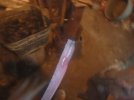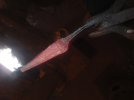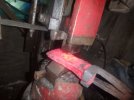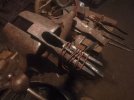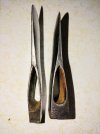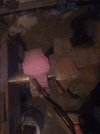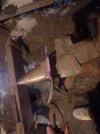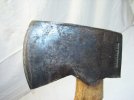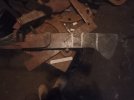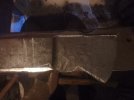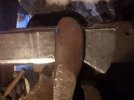I'm between and betwixt here again...Screwed myself for forging yesterday by spacing out the wind direction,and all smoke from charcoaling went Direct inside the forge,couldn't even be in there to think and take measurements!(too much snow around to move my charcoal works downwind,got spoiled by all these days of northerlies

.
Today for a few days got company,and in any case,i'm missing something here...I noticed i'm repeating myself in experiments,without having drawn conclusions...
It's time to Think through some of this.
I went to look some stuff up.Rarely do i turn to watching videos(reception not good enough but other reasons mainly),but This i make an exception for:
This is not voyerism,this is Education,i can't tell you how much respect i have for Dave,and in how many different ways...(speaking incidentally of those tongs above,this is the level of competence that they were made with,right about).
Anyway,two things are the reason i drag this in.One,my theory that about all metal then came from carriage trade supply;remnants of tyre and hardware work were used for everything else(else sold back to supplier).
That's why i keep trying to come up with construction sequence based on strap...
But here's the rub math-wise:If the finished axe blade is within 1/2" say in thickness.
This is for three-part laminate(if bit extends to the eye).Bit steel cannot be under 1/4"+,or it'd be weird....So the remainder,divided by 2,is awfully thin...

...Some went to grinding et c.,but it still leaves under a 1/4" each side in preform...(just thinking out loud here...).
Another awful thought creeps in after watching Dave...I wonder if i'm struggling with hitting sufficiently high heat ranges with my charcoal...It's been Many years since i quit mail-ordering coal from PA(funny that)or WV,the good stuff...I tried coke from PNW,but it somehow worked out the same..Again,it's been a Long time,and i can't compare anymore.
From history i know there used to be a machine shop a couple hundred miles upriver in early 1900's that worked with birch charcoal,and did some heavy work,dredge rigging,et c.(i also heard the rumor that they charcoaled green birch as they went,with waste heat from forging).
I've not enough info though.
What alarmed me in the past is the recommendation in Alaska Miner's Handbook(published regularly since late '3o-ies i think) to buy mineral coal from down south!
And sho nuff,i know that the miners south of here before and after gold rush(mining took a dump here when most guys went off to fight WWI),they all had their coal barged in...
Just tortured by doubt,feeling like i'm balanced right on the verge of necessary heat-range.



